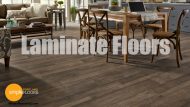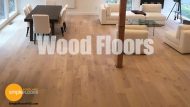Capturing the aesthetics of real wood, laminate wood flooring, with its layered construction for durability, is a stylish, affordable and popular choice for many homeowners and businesses. Though laminate flooring was invented in 1977 by the Swedish company Pergo, they had actually first been developed in the early 1920’s when they began creating durable laminated countertops. These countertops were both moisture and scratch resistant. Over time, the lamination process was modified as new research had been conducted which led to the birth of laminate flooring in 1977. Not long after, the popularity of this new laminate flooring spread throughout Europe and then into North America by the early 1990’s.
Now that you know where laminate floors came from, what do you need to know about this flexible laminate flooring option?
How Laminate Flooring Became Popular
Why is laminate flooring so popular? Laminate flooring quickly became the floor of choice due to several factors of which included affordability, durability, ease of installation, resistance to both scratches and moisture, and being relatively maintenance free. Coupling these factors with today’s new technologies, laminate floors can be manufactured to look like just almost any texture, design style or natural material. With laminate wood flooring, this means that it can be closely replicated down to the color, grain and even texture.
The Durability Of Laminate Wood Flooring
What is laminate wood flooring made of? The construction of laminate wood flooring is made up of four layers of materials.
- Wear layer – This top layer is clear and protects the floor by providing resistance from stains and fading.
- Design layer – This layer is where that new technology comes in by applying a high-resolution as well as detailed photographic image of wood.
- Inner core – This layer packs a punch by providing the essential support to the flooring by way of stability, moisture resistance, sound absorption, and durability.
- Backing – This layer protects the floor from warping by providing a moisture barrier.
Hardwood Versus Laminate Wood Flooring
What is the difference between hardwood and laminate wood flooring? If wood flooring is what you want, the advancement of new technologies has made it so that you can have that look, but at a more affordable price. When looking at the pros and cons of hardwood versus laminate wood flooring, there are a few considerations that will stand out.
- Price – With manufacturing costs much less expensive for laminate wood flooring versus hardwood, coupled with ease of installation, laminate wood flooring is a more affordable choice.
- Durability – Certainly adhering to the manufacturer’s maintenance recommendations for your floor (which can vary based on manufacturer and installation of floor in higher traffic areas) can play a significant role with the long-term durability of your floor. At its core, natural wood is much softer than that of the pressurized composite surface of a laminate floor, and therefore, is much more susceptible to dents and scratches. Laminate flooring can be considerably more durable than flooring made from natural wood materials for specific applications.
- Uniqueness – With natural wood, no two planks are ever the same. With laminate wood flooring, you can replicate the exact look for the wood texture you want with predesigned patterns. But for this reason, when installing the floor, identical patterns are repeated in general, every 5 boards or so. This is done to best reflect a more organic look and feel to your laminate wood flooring.
- Lifespan – Depending on quality of flooring, volume of traffic, and installation, laminate flooring can last anywhere from 15 to 25 years on average. For hardwood floors, they can last anywhere from 25 years to a lifetime depending on thickness of floor installed, sub-floor before installation and quality of care.
Laminate Wood Flooring Is Relatively Maintenance Free
What can you use to clean laminate wood flooring? To wipe away dust, you can simply use a soft cotton or cloth mop. For dirt, you can use a clean cotton cloth. When using a vacuum, be sure to have a hard floor attachment. Avoid scratches by ensuring your vacuum does not have rotary brush heads and instead has a soft bristle one.
Be sure to remove dust and dirt first. You can certainly use a damp cloth mop or cotton cloth for deeper cleaning. Many manufacturers recommend a household cleaner of either 1 gallon of warm water to 1 cup household vinegar or 1 gallon warm water mixed with a 1/3 cup ammonia. When cleaning your laminate flooring, you will also want to make sure you do not pour the solution directly onto the floor or use an excessively wet mop as to best avoid creating a puddle or leaving standing moisture on the floor. As with any spills, try not to allow them to rest upon your floor for any extended lengths of time by cleaning them up as soon as possible. Also, it is recommended that you do not use detergent based cleaners or soap on your laminate floor.
Wood Flooring Is Always In Style
What are some of the current popular trends in wood flooring? Wood flooring is a classic look that never falls out of style. With laminate wood flooring, the sky’s the limit for what look and feel you want to bring to your flooring space.
With wood flooring, here are 5 top trends for style and texture:
- Wire brushed wood floors
- Hand scraped wood floors
- Blonde wood floors
- Dark stained wood floors
- Gray wood floors
With over 3,000 flooring materials, styles, colors and textures in stock, you have many laminate flooring options to choose from. Visit our Portland home design center to find the best design for your home project.









